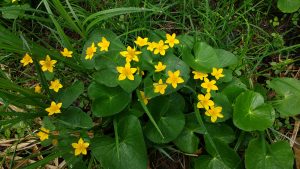
On May 22, a group of 7 Tuesday morning ramblers participated in a flora study walk on Ontario woodland and wetland plants led by Brenda Gallagher, a specialist with the Upper Thames River Conservation Authority. This took place along the Cedar Swamp boardwalk starting at km 52.8 off Road 37.
The swamp is one of four basic types of wetland – the others being marsh, bog and fen. A swamp is forested wetland but unfit for cultivation. The boardwalk was installed by the Avon Trail Association for two reasons (i) to protect the vulnerable vegetation from being trampled and (ii) to keep feet dry. Wetlands are proving to be very important for our wellbeing and for our eco system. There are fewer than 10% remaining in Ontario. Brenda reminded us that (i) every plant has a ‘job’, a purpose, gifts and talents. (ii) most plants are useful or edible in some way, particularly medicinally.
Although Spring was late this year after an exceptionally cold March and April, many plants had awakened from dormancy and had speedily recovered. Over 45 plants were identified along the boardwalk for which Brenda had many insightful and fascinating anecdotes – folklore stories and medicinal uses. Some of these included: Black Willow (Salix nigra) and the history of Aspirin, Yellow Birch (Betula lutea) used at one time by the local indigenous people for canoes rather than the White Birch (Betula pendula) which was used by the northern indigenous people, and Marsh Marigolds (Caltha palustris) which were said to make people go crazy if they stared at them too long due to the bright colour of the flowers. Brenda told us some interesting facts about Water Hemlock and Skunk Cabbage.
Water hemlock (Cicuta spp.) is one of the most deadly poisonous plants in North America. It contains a toxin called cicutoxin, a violent convulsant, which acts as a stimulant in the central nervous system. Ingestion of hemlock can be fatal and grave symptoms can occur 15 minutes to 6 hours after the plant has been ingested.
Trivia: In 399 BC Socrates was found guilty of 2 charges at his trial and was sentenced to death by drinking a poisonous beverage of hemlock.
Skunk cabbage (Symplocarpus foetidus) is in a group of fairly rare plants which are thermogenic. These plants have the unusual ability to create their own heat, often melting the surrounding snow as they first sprout in the spring. Skunk cabbage gets its name from the fact that, when the leaves are crushed or bruised, they give off a smell of skunk or rotting meat. While the smell repels humans and many mammals, it is like perfume to bees, butterflies and many other beneficial insects.
Trivia: The lifespan of Skunk Cabbage is reputed to exceed 100 years.
Special thanks to Brenda Gallagher for a most informative flora study.
< Back to Avon Trail Tales June 2018



